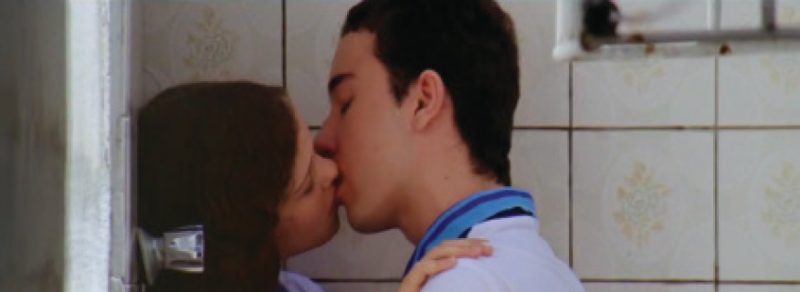There are trailers that tower so monumentally over their thin host films that they become exercises in bad faith: Sofia Coppola’s Marie Antoinette, for instance, or Panos Cosmatos’s Beyond the Black Rainbow. But there is also a rarer sort of trailer, one that hints at the secret interiors of the film, as if the film had withheld a part of itself for the trailer only.
Movies, excepting single-take, no-edit films like Alexander Sokurov’s Russian Ark, already hopscotch through time and space, bending and shaping both in the service of narrative. Trailers do this one level deeper, taking a story that is already by its nature out of time and further wrecking its relationship to linear chronology. Presented out of order, the images in a good trailer suggest a weirdly tyrannical, yet false, coherence.
The carefully orchestrated turbulence of the trailer for the Brazilian film Neighboring Sounds, which lasts just over two minutes, is achieved not through what is depicted in any given shot but rather from the juxtaposition of the shots themselves. There are forty-nine in total, all of them taken from the film, structured roughly like this:
Part 1: Three shots of a character keying an expensive white car.
Part 2: A twenty-two-second clip, comprising six shots, that reveals in one sentence—albeit obliquely—the film’s central plot point.
Part 3: Forty shots, set to music by DJ Dolores, each lasting between half a second and two seconds.
The ghostly assembly of shots, in the third part in particular, conveys a danger that is felt but invisible, not communicated by characters except perhaps through code. This feeling represents the cumulative, boiled-down danger of the film itself—yet it adds a sense of violence and disorientation to what is found therein.
Two shot sequences stand out. Shots ten and eleven both involve forward movement, but of radically different sorts: shot ten is a slow, gliding-forward tracking shot that pushes through a sunny soccer court filled with kids, while shot eleven cuts to a fast zoom-in revealing a security man on an empty street. The unexpected cut between languorous forward movement and whiplash zoom momentum shocks, even hurts. Some seconds later, shots sixteen and seventeen, edited together as they are, also have an unsettling effect: sixteen pans quickly to the left, seventeen to the right. The closest word for the feeling is urgency, an urgency born out of fear. But fear of what?
The trailer’s suggestion of violence happens not with gunshots or explosions but with the empty space around the main characters, which suggests additional presence. A small television set showing what appears to be surveillance footage. A child pulling shut the iron, jail-like door of his home. The waves of the ocean crashing at night. A fender bender involving two unknown cars. The figure of a person running through the night. Someone in a dark room opening a door to the sunlight, the shot cutting away just before the light reveals who or what is in the room.
The overall effect is like finding yourself, in a dream, strapped to a rocket counting down to takeoff and wondering not what is going to happen but how it will unfold. The feeling is not unlike a few sentences from Roberto Bolaño’s novel Distant Star: “He looked like a snake. No, like a pharaoh. He was just sitting there smiling and watching me, but it was as if he was moving around the empty flat. How could he be moving and sitting still at the same time?”
In the trailer’s eighteenth shot, two young people are kissing in the sunlight when suddenly the girl pulls away and looks—as one who condemns and accepts condemnation at the same time—directly at the camera. Not in a way that conveys another postmodern moment of self-reference, but in a way akin to the gun pointed at the camera at the beginning (or the end, depending on where the projectionist at the particular theater wanted to put it) of Edwin S. Porter’s 1903 The Great Train Robbery: a look that seamlessly integrates the viewer into the story. We expect something to happen, but what? Come on, the girl seems to say, eyes locked on the camera. You know that whatever’s coming is bringing destruction with it, right?
—Nicholas Rombes





